早发型脊柱侧凸 您需要知道的那些事儿
2017-06-25 文章来源:首都医科大学附属北京朝阳医院 张扬璞 海涌 我要说
Consensus Statement
专家共识
EARLY ONSET SCOLIOSIS CONSENSUS STATEMENT
SRS GROWING SPINE COMMITTEE, 2015
早发型脊柱侧凸专家共识
国际脊柱侧凸研究学会,儿童脊柱委员会,2015
译者 张扬璞 海涌
前言
早发型脊柱侧凸,是脊柱侧凸中并不少见且诊治复杂的疾病之一。由于发病年龄小,患儿还处在生长发育的关键时期,如何控制和治疗侧凸的发展以及如何尽可能保持脊柱和胸廓胸腔的发育,成为了治疗的难点和焦点,也是脊柱畸形领域充满争议和最具挑战的难题。
针对这一特殊疾病,国际脊柱侧凸研究学会(SRS, Scoliosis Research Society),于2015年在脊柱畸形杂志发布了早发型脊柱侧凸诊治的专家共识,试图对这一组特殊脊柱畸形诊断和治疗,提供目前循证医学的证据和参考意见。笔者在此将该共识翻译出来,以供广大脊柱外科同道参考。
(引自:David L. Skaggs, MD, MMM, Tenner Guillaume, MD, et,al. Consensus Statement: EARLY ONSET SCOLIOSIS CONSENSUS STATEMENT, SRS GROWING SPINE COMMITTEE, 2015, Spine Deformity 3 (2015) 107)
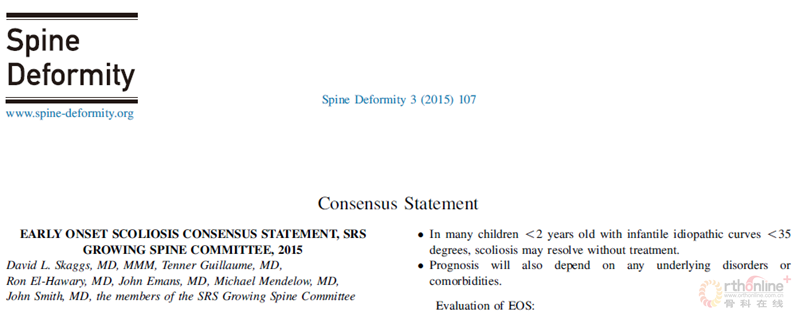
Early Onset Scoliosis (EOS) refers to spine deformity that is present before 10 years of age. EOS is further organized to reflect etiology as applicable:
早发型脊柱侧凸(EOS)是指10岁之前表现出的脊柱侧凸畸形。EOS可以进一步进行分类以反映病因,应用如下:

早发型脊柱侧凸
Diagnostic Categories of EOS:
EOS诊断分类:

EOS分型(C-EOS)
(摘自 Williams B A, Matsumoto H, et al. Development and initial validation of the Classification of Early-Onset Scoliosis (C-EOS).[J]. Journal of Bone & Joint Surgery American Volume, 2014, 96(16):1359-67.)
Idiopathic:
● Curves for which there is no apparent cause or related underlying etiology.
■ Infantile idiopathic-a subgroup of idiopathic curves which develop in infants and children less than 3.
特发性:
● 没有明显的原因或相关的潜在病因的侧凸。
■ 幼儿特发性——指发生在婴儿和小于3岁的儿童的特发性侧凸。
Congenital:
● A particular type of EOS in which the vertebrae develop incorrectly in utero.
■ Congenital scoliosis is sometimes associated with cardiac and renal abnormalities. Evaluation may include studies of heart and kidneys.
先天性:
● 是指在子宫内椎体未正常发育的一种EOS类型。
■ 先天性脊柱侧凸有时伴随有心脏和肾脏的异常。进行评价时可能要包含有关心脏和肾脏方面的检查。
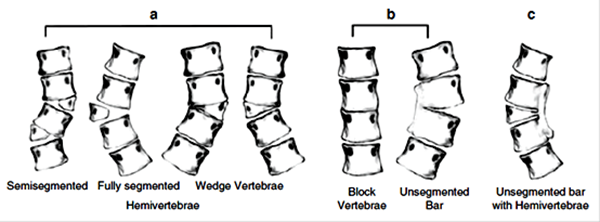
椎体发育异常
Thoracogenic:
● A particular type of EOS that may be encountered in the following settings:
■ Multiple congenital rib fusions as seen in spondylocostal or spondylothoracic dysostosis, which may have congenital vertebral anomalies as well and may also be considered congenital scoliosis.
■ Changes in the chest wall following thoracic surgery which may function as a tether which promotes change in the shape of the spine.
胸源性:
● 可能发生在下列情况中的一种EOS类型:
■ 在脊柱肋骨或脊柱胸廓发育不全中常见的多发先天性肋骨融合,可能同时伴有先天性椎体发育异常,也可以认为是先天性脊柱侧凸。
■ 胸部手术术后胸壁的改变可能成为促进脊柱形状的变化的系带。
Neuromuscular:
● Scoliosis which may develop in children with neuromuscular disorders including spinal muscular atrophy, cerebral palsy, spina bifida and brain or spinal cord injury.
神经肌肉型:
● 脊柱侧凸可发生在患有神经肌肉疾病的儿童上,包括脊髓性肌萎缩,脑瘫,脊柱裂和脑或脊髓损伤。
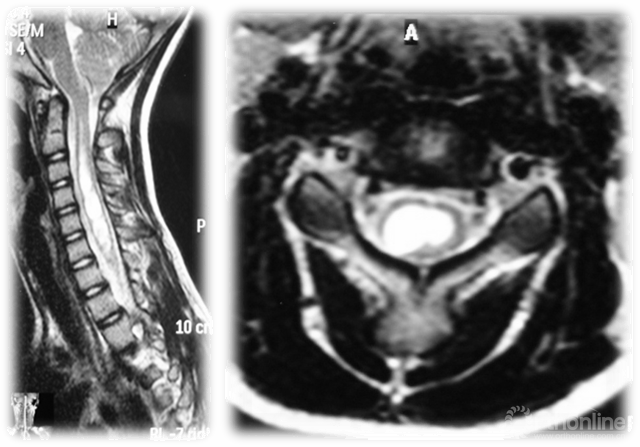
脊髓空洞
Syndromic:
● Certain syndromes, such as Marfans, Ehlers-Danlos and other connective tissue disorders, as well as neurofibromatosis, Prader-Willi, and many bone dysplasias may be associated with EOS.
综合征型:
● 某些综合征,比如马凡氏综合征,埃-当综合征和其他结缔组织疾病,还有神经纤维瘤病,Prader-Willi综合征,以及许多骨发育不良都可能与EOS有关。
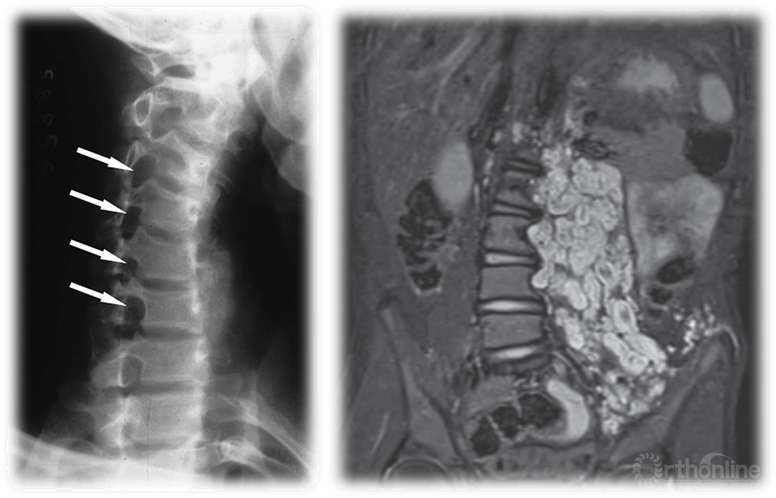
神经纤维瘤病
Prognosis of EOS:
● EOS, depending on the severity, may be associated with compromised pulmonary function in childhood which may also become increasingly problematic in adult years.
● When untreated, severe EOS may be associated with an increased risk of early death due to pulmonary compromise.
● The term Thoracic Insufficiency Syndrome (TIS) is commonly used to describe the potential combined spine and pulmonary problems in EOS. TIS is defined as ‘‘the inability of the thorax to support normal respiration or lung growth’’.
● Idiopathic EOS with a Cobb angle of O35 degrees is likely to progress.
● In many children <2 years old with infantile idiopathic curves <35 degrees, scoliosis may resolve without treatment.
● Prognosis will also depend on any underlying disorders or comorbidities.
EOS的预后:
● EOS,根据其严重程度,可能与幼年时期的肺功能有关,同时可能成为成年以后日益突显的问题。当未接受治疗时,重度EOS可能会由于肺功能损害而增加早逝的风险。
● 术语胸廓发育不良综合征(TIS)通常被用于描述合并有脊柱与肺功能潜在问题的EOS患者。TIS被定义为“胸腔无法支持正常的呼吸或肺部的生长”。
● Cobb角大于35°的特发性EOS有可能会进展。
● 对于许多不到两岁的孩子伴有小于35°的幼儿特发性侧凸,无需治疗可能就会解决。
● 预后也将取决于任何潜在的疾病或并发症。

胸廓与肺泡的发育
(摘自:Boyden EA. Development of the pulmonary airways. Minn Med. 1971 Nov;54(11):894-7)
Evaluation of EOS:
● Plain X-rays are sufficient to make the diagnosis of EOS.
● MRI may be indicated for curves that are larger than 20 degrees or progressive, or if there are signs or symptoms of neurologic problems and in persistent or progressive infantile idiopathic scoliosis. Intraspinal abnormalities are commonly associated with EOS, particularly congenital scoliosis.
● CT best helps visualize bone anatomy in congenital scoliosis, and is often useful for surgical planning, but must be weighed against risk of radiation to young child.
EOS的评估:
● 普通的X线检查足以诊断EOS。
● MRI可提示超过20度的侧凸或侧凸的进展,或者有迹象或症状的神经问题,以及处在稳定或进展的幼儿特发性脊柱侧凸。脊柱的异常通常与EOS有关,特别是先天性脊柱侧凸。
● CT是最有助于使先天性脊柱侧凸的骨骼解剖得到可视化,通常也对手术方案的制定有所帮助,但必须权衡给年轻孩子带来的辐射风险。
Treatment Goals in EOS:
● Minimize spinal deformity over the life of the patient.
● Maximize thoracic volume and function over the life of the patient.
● Minimize the extent of any final spinal fusion, maximize motion of chest and spine.
● Minimize complications, procedures, hospitalizations and burden for the family.
● Consider overall development of the child.
EOS的治疗目标:
● 使患者的脊柱畸形最小化。
● 使患者的胸部容积和功能最大化。
● 使最终脊柱融合的程度最小化, 胸部和脊柱的运动最大化。
● 减少并发症、手术、住院和家庭负担。
● 考虑到儿童的全面发展。
Treatment options in EOS may include:
EOS治疗方案包括:
● Observation:
■ The behavior of the curve may be monitored via repeated exam and radiographic evaluations at various time-points during development to look for worsening or progression of the scoliosis. Should the curve progress, or if the curve is larger, treatment may be appropriate:
● 观察:
■ 对侧凸变化的监测可以通过在侧凸进展过程中选取多个时间点进行重复性测量和影像学评估而完成,以评估侧凸的恶化和进展。如果监测发现侧凸进展或角度增加,则需要采取治疗措施。
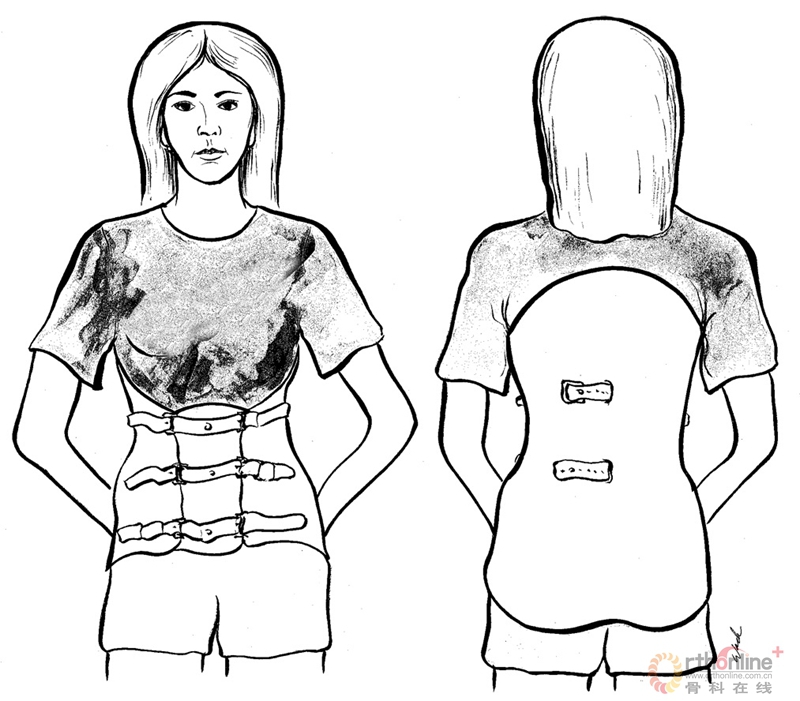
支具治疗
● Bracing or casting:
■ Bracing or casting programs may help by allowing growth while minimizing curve progression. The need for surgery may be delayed and, in some instances such as infantile idiopathic scoliosis, surgery may be avoided. Anesthesia is usually required for casting children. Bracing or casting congenital scoliosis is rarely effective, but some believe bracing or casting a compensatory curve may be helpful.
● 支具或石膏固定:
■ 支具或石膏固定手段可以通过允许脊柱生长的同时使侧凸发展程度最小化。这样,患者的手术时间可以被推迟,甚至在某些情况下,如小儿特发性脊柱侧凸,手术可以避免。当石膏固定的对象是儿童时,则通常需要麻醉。支具或石膏固定先天性脊柱侧凸很少有效,但一些学者相信以支具或石膏固定为手段创造一个代偿性弯曲可能是有益的。
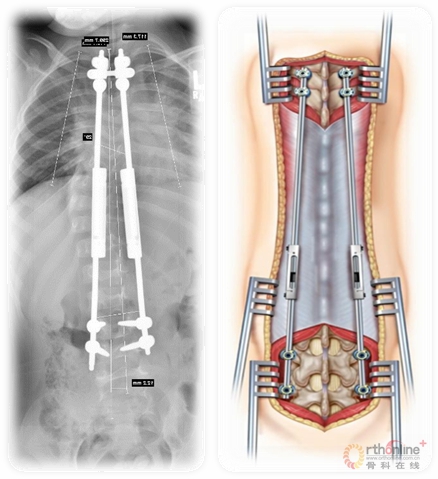
磁控生长棒技术
● Surgery:
■ Various growth-friendly surgeries are designed to follow the principles of EOS treatment outlined above, allowing the spine and chest to grow while controlling spine and chest deformity. Surgery is generally recommended if brace or cast treatment should fail to control progression, or if curve pattern does not appear amenable to brace or cast treatment.
■ Extensive thoracic spinal fusion in the very young child is associated with pulmonary compromise, and is rarely the best option.
● 手术:
■ 各种个体化的手术是为了遵循上述EOS治疗原则,使脊柱和胸部得到生长的同时控制脊柱和胸部的畸形。当支具或石膏固定控制侧凸进展失败或侧凸类型并不适合支具或石膏固定时,一般建议手术治疗。
■ 广泛胸椎融合的年轻儿童考虑到其肺部的生长,手术治疗则很少是最好的选择。
● Exercise:
■ Manipulation, physical therapy and/or exercise has not been shown to influence spinal deformity in EOS.
● 锻炼:
推拿、物理治疗和/或运动还没有被证明在EOS中影响脊柱畸形。





 京公网安备11010502051256号
京公网安备11010502051256号